The best microSD cards
SanDisk and Samsung lead the pack.

By Nathan Edwards
This post was done in partnership with Wirecutter. When readers choose to buy Wirecutter's independently chosen editorial picks, Wirecutter and Engadget may earn affiliate commission. Read the full micro SD cards guide here.
After testing more than 20 new and updated microSD cards, we've found that the SanDisk MicroSDXC card for Nintendo Switch (128 GB) is the best for most phones, tablets, and, yes, Nintendo Switches, but there are several other cards that work fine. The hard part is finding a real one; the online marketplaces are flooded with counterfeits.
The Switch card is fast, consistent, comes from a reputable company, has a picture of a mushroom on it, and works in anything that takes a microSDXC card, not just the Switch. Most of the 128 GB cards we tested are fast enough but are more expensive and harder to find, or were slower than the Switch card in one or more tests. The Switch card performed well in all of them and (for now, at least) is easy to find without sorting through a bunch of third-party sellers hawking fakes.
If the SanDisk Switch card is too expensive or unavailable from first-party sellers, or if you need a card that's on GoPro's compatibility list, get the Samsung Evo Select (128 GB). The Evo Select is an Amazon-exclusive rebrand of the Samsung Evo Plus, and it's almost always available. Its random write speeds aren't as good as the Switch card's, so it's not as good for running apps or operating systems, but its sequential speeds are right up there, so it's great for media storage and recording, and it's usually a buck or two cheaper.
We have found that 128 GB microSD cards are the most cost-effective capacity right now. But if you don't need all that space or you just want to save a few bucks, we recommend any of the following cards: The SanDisk MicroSDXC card for Nintendo Switch (64 GB) is among the fastest cards we tested in every benchmark, but the 64 GB capacities of the Evo Select or the Kingston Canvas React, Canvas Go, and Canvas Select are fine too.
Who this is for
You'll find microSD cards being used for expanded storage in some smartphones, tablets, and laptop computers; as the main video and photo storage for action cameras like GoPros; and to hold downloaded games in portable consoles like the Nintendo Switch. Some small computers, especially kit computers like the Raspberry Pi, use them as their main storage for the operating system and programs.
Make sure your device has a microSD card slot before you buy. And if the device is a few years old, make sure it supports microSDXC (microSD Extended Capacity); otherwise you'll need to get a card that's 32 GB or less. If your device has a full-size SD card slot, you can get an SD card or buy a microSD card with an adapter (like the Samsung Evo Select). Full-size SD cards used to be significantly faster than microSD cards, but that's not really the case anymore.
How to avoid counterfeit cards
Beware when buying microSD cards online. Amazon is choked with third-party sellers hawking counterfeit memory cards. For some SanDisk models, we could find only third parties selling probable fakes or shipping older cards in place of the advertised model.
To avoid getting scammed, never buy from third-party vendors on big marketplace sites. Look for "Ships from and sold by Amazon.com," or buy directly from a reputable seller like Best Buy or Adorama. If you get your card from Amazon or any other retailer that provides packaging choices, be sure to select the original packaging (not Amazon's "Frustration-free" packaging, for example). This is one instance in which buying from a big-box store, in person, is a good idea; you'll almost always pay more, but you're more likely to get the genuine article.
Some Amazon customers have reported receiving fake cards directly from Amazon. If you suspect your card is a fake (look for strange packaging and test the card with CrystalDiskMark to check its speeds), contact Amazon customer support for an exchange.
How we picked
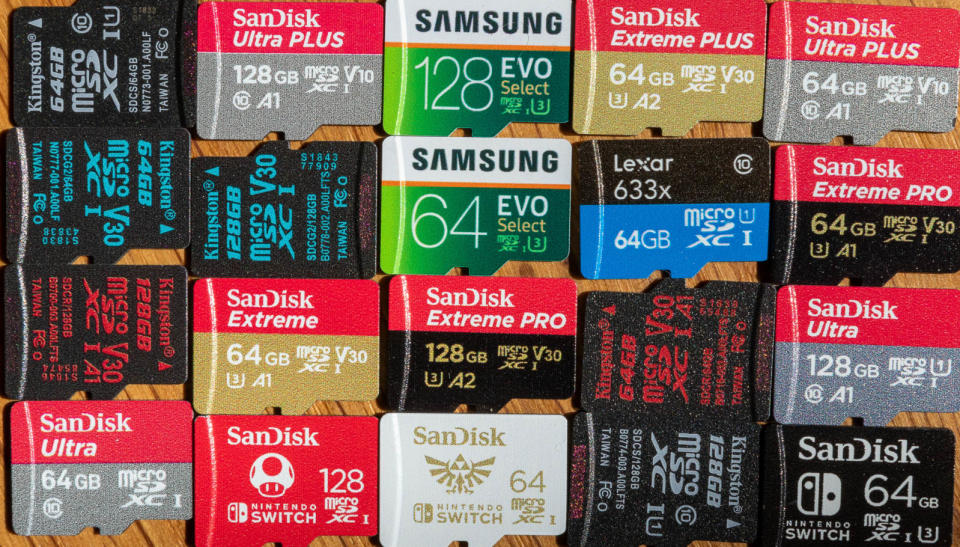
These days, microSD cards are mostly used for expanded media storage (in phones and tablets), recording video (in action cameras), and storing downloaded games (in consoles like the Nintendo Switch).
This is what you should look for in a microSD card, regardless of how you plan to use it:
Availability: Because microSD cards are so often faked, and fake cards don't have the same advertised capacity, are much slower, and aren't warrantied, it's vital that the card be available from reputable first-party sellers, like Best Buy or Amazon. Never buy from a third-party seller, even if they're selling through a major retailer.
Sequential speed: Sequential reads show how fast big chunks of data can be read from the card. They're important for watching movies, loading game levels, or copying data from the card to your computer. Sequential writes are important for shooting video and high-resolution photos, and copying media to the card.
Random speed: A microSD card used for operating systems, applications, or games needs to be fast at reading and writing small bits of data in random locations. This is especially important for cards used to run operating systems or programs (in a Raspberry Pi or one of the few Android phones that still let you run apps from microSD) or load game levels (like in a Nintendo Switch).
Speed rating: The SD association has three overlapping speed rating systems. All the cards we tested are at least Class 10 or U1 rated cards. Both of those designations mean the card can write sequential data at at least 10 MB/s—the bare minimum for shooting 1080p video. Many of the cards we tested for this update are rated U3 or V30, both of which guarantee a minimum sequential write speed of 30 MB/s, enough for 4K video. Unless your device specifically requires a lower speed class (such as Class 2, 4, or 6), you should look for a card rated U1 or U3. V60 and V90 microSD cards, which are fast enough to record 8K video, are expensive and require relatively rare UHS-II bus devices, so we didn't test any.
Capacity: You can get a good 128 GB microSD card for less than $30; most are cheaper per gigabyte than their 32 GB, 64 GB, and 256 GB counterparts. Check your device to make sure it supports SDXC (extended capacity) cards before buying one. If not, stick with 32 GB.
UHS-I bus mode: Bus mode is a standard that dictates how different generations of SD cards work. You should get a UHS-I bus card, unless the device you're using specifies that it supports UHS-II. You won't get the full speed of UHS-II unless both device and card have support, because it requires an additional row of physical pins to achieve its extra speed. All our picks are UHS-I; we didn't test any UHS-II cards because few devices need them and UHS-II cards are very expensive.
Warranty: The longer the warranty, the better. Although we didn't eliminate cards for having a shorter warranty, we noted ones that offered 10-year limited and lifetime limited warranties. It also helps to get a reliable card from a reputable manufacturer like Samsung, SanDisk, or Kingston to minimize the chances of something going wrong.
Application Performance rating: The A1 or A2 ratings guarantee minimum levels of performance for running apps, but few phones or tablets can run apps from microSD cards anymore, so A ratings aren't that relevant.
Our pick: SanDisk MicroSDXC card for Nintendo Switch (128 GB)

The SanDisk MicroSDXC card for Nintendo Switch (128 GB) is the best microSD card for phones, tablets, and, yes, the Nintendo Switch. It's fast, inexpensive, and sold directly at Amazon and Best Buy, so you're likely to get a genuine one. None of the cards we tested were equally good at everything, but the Switch card was good-to-great in every test, and it didn't tank in any of them, unlike many of the cards we tested.
SanDisk is one of the world's most reputable flash storage manufacturers, and it's one of the few that still makes its own memory rather than outsourcing to another company. We tested two variants of the Switch card, the 128 GB SDSQXAO-128G-GNCZN as well as the 64 GB SDSQXBO-064G-ANCZA. The 64 GB version performed nearly identically to the 64 GB SanDisk Extreme (we didn't test the 128 GB Extreme), but the Extreme is a frequent target of counterfeiters. The Switch card, for now, is available directly from Amazon, which makes it safer to recommend since getting a real one is easier. It also has a jaunty red color with a Mario mushroom on it, which is nice.
The Nintendo Switch card is a U3, V30-class card, which means its sequential write speeds stay above 30 MB/s, enough to record 4K video. In our tests, it far exceeded those numbers, with sequential write speeds of 83 MB/s on a computer and 54 MB/s on a Samsung Galaxy S9 smartphone (see more test results below).
Though tiny and easy to lose, microSD cards are durable and can withstand bumps and drops. SanDisk offers a lifetime limited warranty and rates its cards to survive salt water, magnets, X-rays, and extreme temperatures, but not fire or being ingested by a small child or pet. Samsung makes similar claims about their cards.
Flaws but not dealbreakers
Random speeds represent how quickly small bits of data scattered around the card can be read and written. The Switch card's A1 random reads were below the average of the cards we tested, at 9.1 MB/s. The fastest card we tested was 13.73 MB/s, the slowest was 9 MB/s, and the average was 10.5 MB/s. Its random writes were better, at 2.4 MB/s; the highest was 3.9, the average was 2.7, and the lowest was just 1.4 MB/s. None of these results are terrible—we didn't test cards we knew would be slow, and for most uses, sequential speeds are more important. But if you're going to run an operating system from the card (as on a Raspberry Pi) consider a Kingston Canvas card, which had considerably higher random speeds, instead.
The SanDisk MicroSDXC card for Nintendo Switch has gone through several revisions; a black version (SDSQXBO-128G-ANCZA, 128 GB, and SDSQXBO-064G-ANCZA, 64GB, both still available at Best Buy) and the one on Amazon, which is red with a mushroom (SDSQXAO-128G-GNCZN, 128 GB version), or white with a Triforce (SDSQXAT-064G-GNCZN, 64 GB version). SanDisk told us that these versions are identical inside, and they both perform about as well as the SanDisk Extreme cards, but microSD cards are often quietly revised, so there's no guarantee that that will be the case forever.
Unlike the SanDisk Extreme, the Switch card does not appear on GoPro's list of recommended microSD cards, so if you're buying a card for a GoPro consider the 128 GB Samsung Evo Select, which does. The Switch card should be more than fast enough to work in the GoPro, but if any issues crop up, it's better to be using a card on the compatibility list.
It's also possible that as the MicroSDXC Card for Nintendo Switch gets more popular, it'll be harder for first-party stores to keep it in stock, and it'll fall victim to the same third-party sellers and counterfeiters as many other microSD cards.
Runner-up: Samsung Evo Select (128 GB)
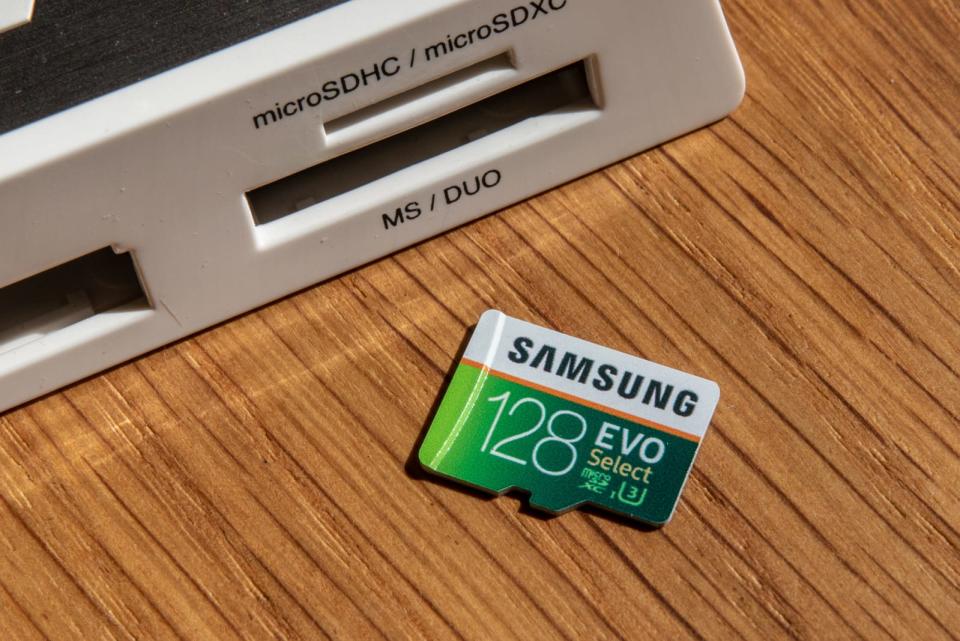
If you're buying a card for a GoPro camera, or the SanDisk Switch card is sold out, too expensive, or unavailable from a first-party seller, the Samsung Evo Select (128 GB) is a fine alternative. Its A1 random write speeds aren't as fast as the Switch card's, so it's not ideal for running apps, but it has fast sequential speeds, it's reliable, it's inexpensive, and it's always available directly from Amazon (as opposed to third-party sellers), so you should be able to avoid fakes.
The Evo Select is a Class 10, U3-rated card. In CrystalDiskMark's sequential tests, the 128 GB Evo Select had about the same speed as the Switch card; both were among the fastest we tested. Its random performance was a little lower but not much (within a third of a megabyte per second in both tests). You won't notice a difference.
In A1, the Evo Select was 10 MB/s slower than the Switch card in sequential writes and about 2 MB/s faster in random reads, but it was 1 MB/s slower in random writes. It had the slowest random writes of any card we tested this time, except for its 64 GB counterpart. You probably won't notice a difference, though copying files to the card might feel a little slower.
The Evo Select is an Amazon-exclusive rebrand of Samsung's Evo Plus microSD cards, and in the several years it was our top pick it never went out of stock. It's also one of the least expensive good microSD cards you can get, though the Switch cards are now usually within a couple of dollars.
The 128 GB Evo Select appears on GoPro's list of recommended microSD cards, unlike the Nintendo Switch card or the 64 GB Evo Select. It carries a 10-year limited warranty, which is about standard for microSD cards.
Budget pick: SanDisk MicroSDXC card for Nintendo Switch (64 GB)
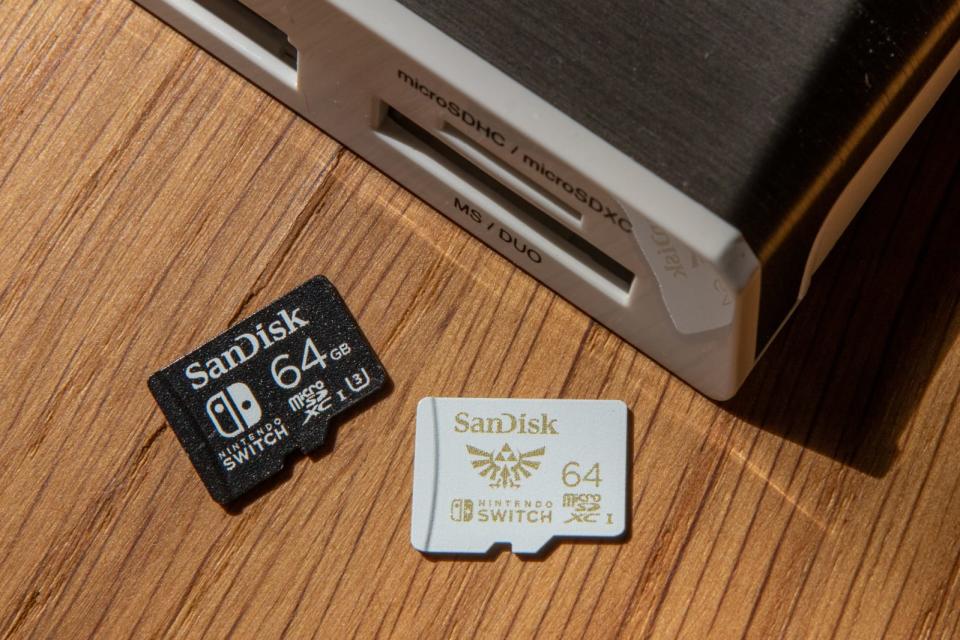
If you don't need 128 GB of storage or you're trying to save a few bucks, the SanDisk MicroSDXC card for Nintendo Switch (64 GB) is a great choice, though there are a handful of good options. The 64 GB Switch card is a few dollars more expensive than the 64 GB Samsung Evo Select and the Kingston Canvas React, Canvas Go, and Canvas Select, but did better in our A1 smartphone benchmark than any of them, with significantly higher sequential writes. That said, you likely won't notice a difference in everyday use, so just get whichever of those cards is cheapest and available directly from the store (no third-party sellers).
Test results and how we tested
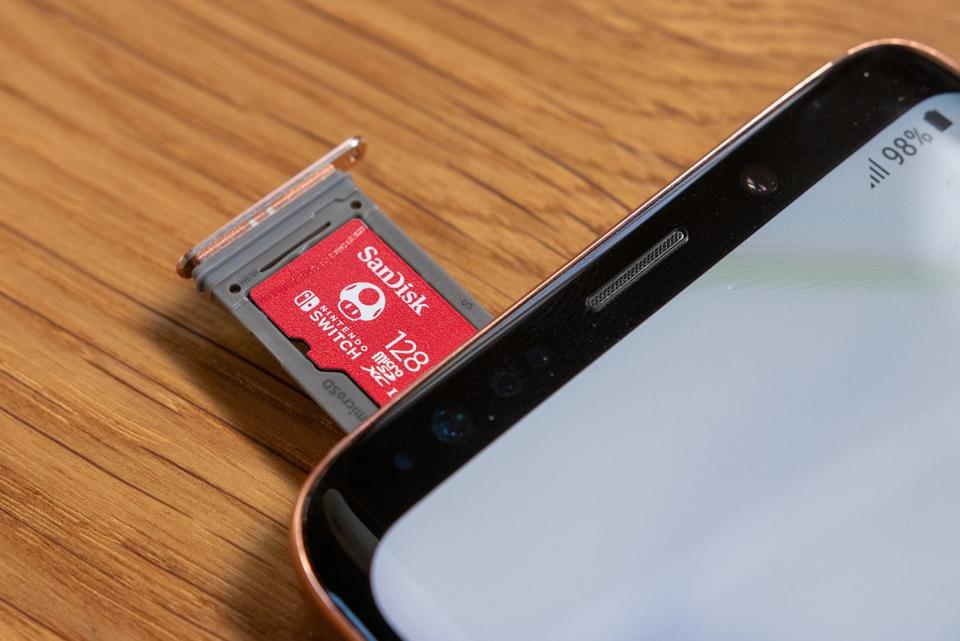
We researched 30 microSD cards that are new or have been updated since the last batch of eight cards we tested in 2017. We tested both the 64 GB and 128 GB versions of the Samsung Evo Select; the SanDisk MicroSDXC Card for Nintendo Switch, SanDisk Ultra, Ultra Plus, and Extreme Pro; Kingston Canvas Select, Canvas Go, and Canvas React; and the 64 GB models of the SanDisk Extreme, SanDisk Extreme Plus, and the Lexar 633x.
Using a Kingston USB 3.0 High-Speed Media Reader in a desktop PC's USB 3.0 port, we ran CrystalDiskMark, a benchmarking program designed to test sequential and random speeds on solid-state storage. We ran each test three times and averaged the results. Between each test, we reformatted each card using the recommended utility from the SD Association to stabilize performance. We also tested each card's sequential and random speeds on a Samsung Galaxy S9 using A1 SD Bench. (You can read more about how the benchmark works at the A1:dev website.)
Every card we tested had consistent performance between runs, but not between devices. Sequential speeds and random write speeds were higher with CrystalDiskMark on the desktop than with A1 on the Galaxy S9, while the A1 benchmark recorded consistently higher random reads.1 You're much less likely to be running apps or loading game data from microSD on a computer, so we paid more attention to A1 random results than CrystalDiskMark's. Conversely, the desktop PC was able to run the cards closer to their sequential speed limits; the Galaxy phone bottlenecked them, so we paid more attention to CrystalDiskMark than A1 for sequential speeds.
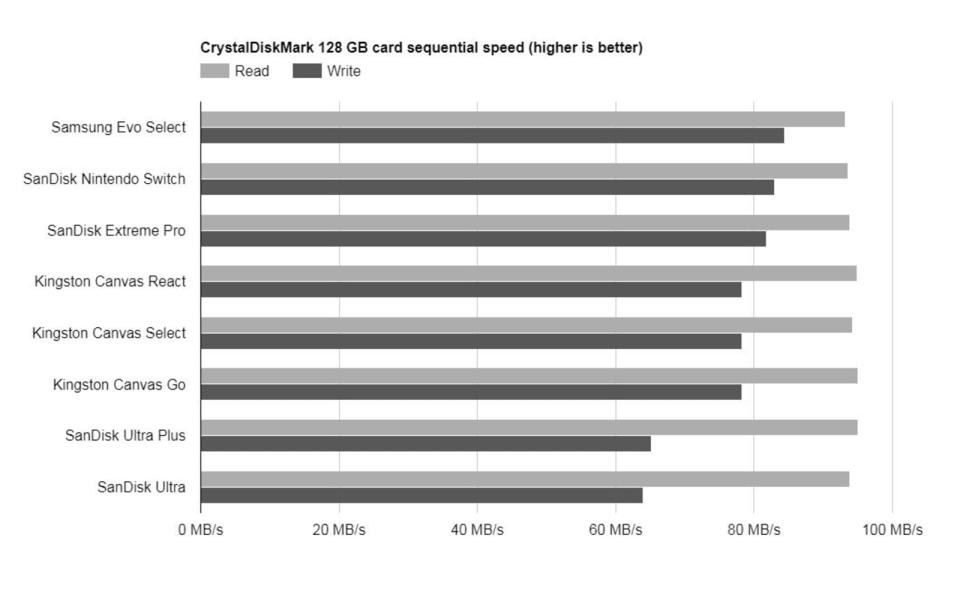
Sequential read speed indicates how fast long swathes of data can be read from the memory card—for example, when you're watching a movie stored on the card, loading a game level, or copying photos or videos from the card to your computer. Sequential writes are important when putting big chunks of data onto the card: recording a video, shooting pictures, or downloading a movie or a game to your device. All of the cards had sequential read speeds around 90 to 95 MB/s, about the limit of the UHS-I bus, in our CrystalDiskMark testing. Sequential writes were a bit more varied; most cards did fine, with results between 70 and 85 MB/s.
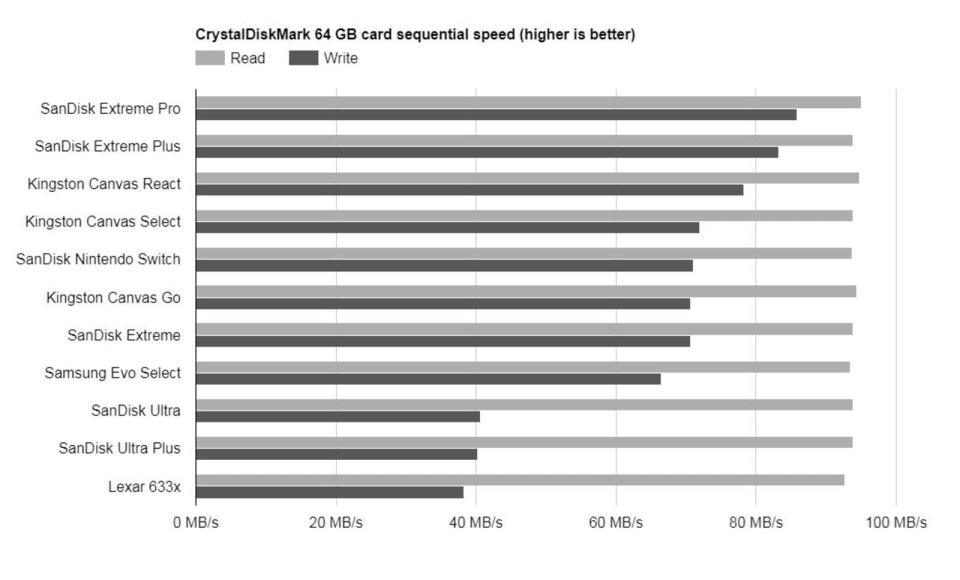
Since microSD cards are mostly used for media storage these days, sequential speeds matter more, but random access speed is still important. Apps often save data in small chunks scattered across the storage device, so a microSD card used for operating systems, applications, or games needs to be fast at reading and writing small bits of data (often around 4 KB) in random locations. Most Android devices no longer let you run apps from external storage, but if your operating system and programs live on the card (as in a Raspberry Pi) or you're playing a game downloaded to it (as on a Nintendo Switch), it's important that your random read and write speeds don't hold you back.
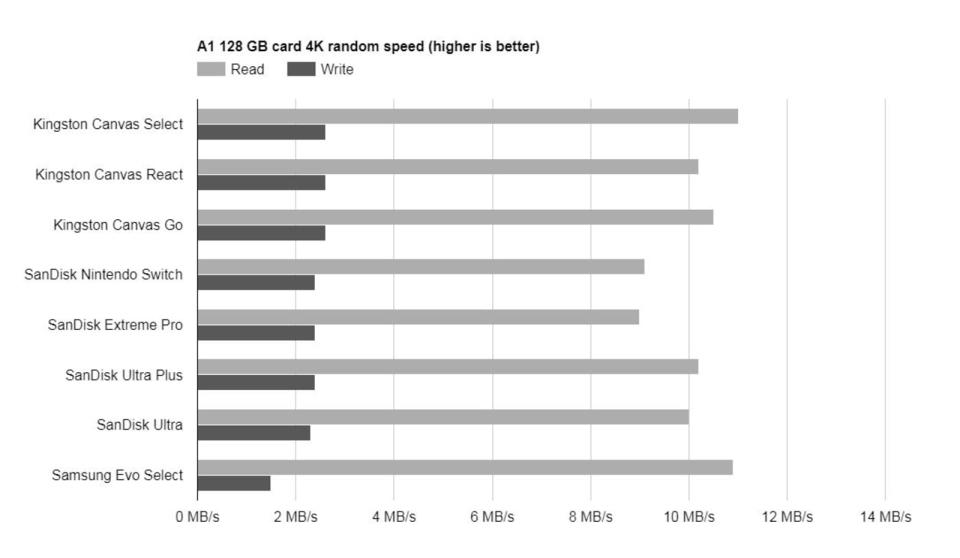
Among the 128 GB cards, random read performance in A1 ranged between 9 and 11 MB/s. Random writes were slower (as they always are) and between 1.5 MB/s and 2.6 MB/s. The Kingston Canvas cards dominated both random read and write speeds; they'd be good choices for running applications from, but their sequential speeds, which are important for reading and writing media, were slower than those of the Switch and Evo Select cards.

In our smartphone random speed tests, the 64 GB cards we tested were faster than their 128 GB counterparts. The 64 GB Nintendo Switch, SanDisk Extreme, and Extreme Pro dominated here, while the Samsung Evo Select had among the best random reads but the worst random write scores of any card we tested this time. All of these are still fast enough; we haven't experienced or seen reviewers complaining about performance except when looking at benchmarks.
CrystalDiskMark's random results were a little different; the Evo Select cards fell in the middle of the pack instead of dead last, and Kingston's trio of Canvas cards—the Canvas Go, Canvas React, and Canvas Select—were right at the top. If you're buying for a Raspberry Pi or other use where you'll be doing a lot of random writes, they're great options.
The competition
Most of the cards we tested work well enough, but fell short of our picks in price, speed, or availability, so they're not the first you should consider.
The Kingston Canvas React, Canvas Go, and Canvas Select cards are nearly identical in price and performance, though they carry different speed class ratings. The React is rated U3 and V30 and has an A1 application performance rating; the Go is V30 and U3; and the Select only carries U1, though they all did about the same in our benchmarks. Compared with the Switch card and Evo Select, they had surprisingly high random write speeds in CrystalDiskMark but lower random read speeds. They're decent alternatives if our picks are out of stock, but most people should consider the Nintendo Switch or Evo Select cards first if they're available.
The 64 GB and 128 GB SanDisk Ultras had significantly slower sequential write speeds than our picks and lower random speeds overall, but they're easy to find legit at Amazon. They have tons of great reviews, but the Evo Select, Kingston Canvas, and Nintendo Switch cards are faster and cost only a few dollars more.
The SanDisk Extreme Pro UHS-1 cards (64 GB and 128 GB) did well in our tests but not notably better than the MicroSDXC Card for Nintendo Switch. They also cost a lot more, and they're hard to find: Every listing we found on Amazon was a third party, some were shipping different cards than advertised, and even SanDisk couldn't tell us where to get a real one.
Some 128 GB SanDisk cards we tested (Extreme, Extreme Plus, Extreme Pro, plus the probably-a-rebranded Extreme Nintendo Switch card) hit sequential read speeds of over 175 MB/s and writes of around 100 MB/s when tested in a SanDisk MobileMate USB 3.0 Reader rather than the Kingston reader we used for our regular testing. If you spend most of your time every day transferring large files between a microSD card and a computer—say you rent out GoPros at a ski resort—it might be worth picking up the MobileMate reader, but the speed increase only works with the 128 GB versions of the Extreme cards, most of which we don't recommend.
We tested the 64 GB SanDisk Extreme Plus and Extreme cards; both did about as well as the Switch card but are hard to find from reputable sellers and are too expensive anyway.
The 64 GB and 128 GB SanDisk Ultra Plus are more expensive than the Ultras, harder to find, massively counterfeited, and no faster.
The 64 GB Lexar 633x had the worst sequential CrystalDiskMark speeds, but it had among the best random speeds in both tests. Lexar is a storied brand with an uncertain future; its parent company Micron sold the brand in 2017, and the new owner, Longsys, only resumed production in mid-2018. Lexar doesn't yet have the track record of Samsung, SanDisk, or Kingston, so for now we prefer those cards.
This guide may have been updated by Wirecutter. To see the current recommendation, please go here.
When readers choose to buy Wirecutter's independently chosen editorial picks, Wirecutter and Engadget may earn affiliate commissions.
